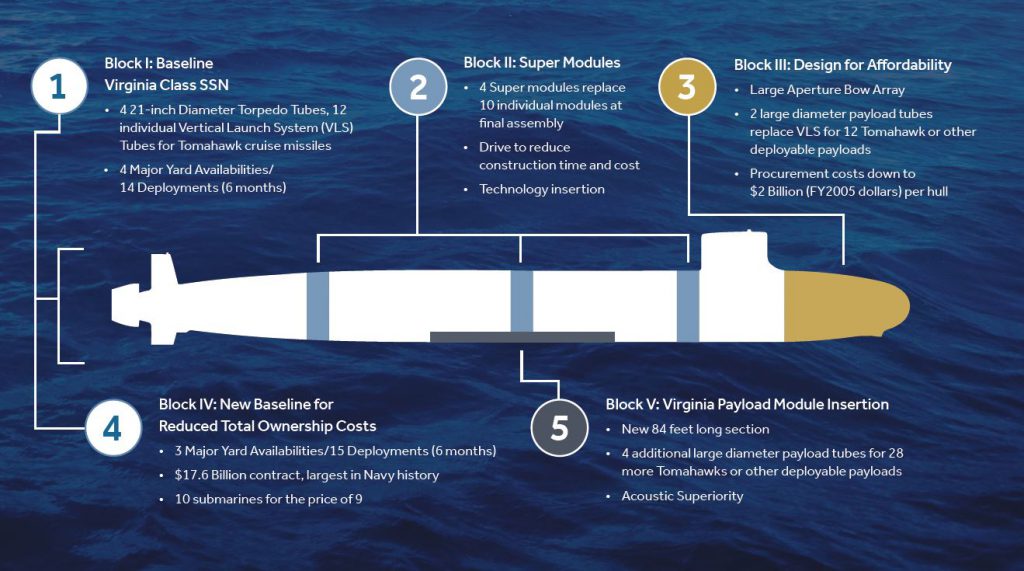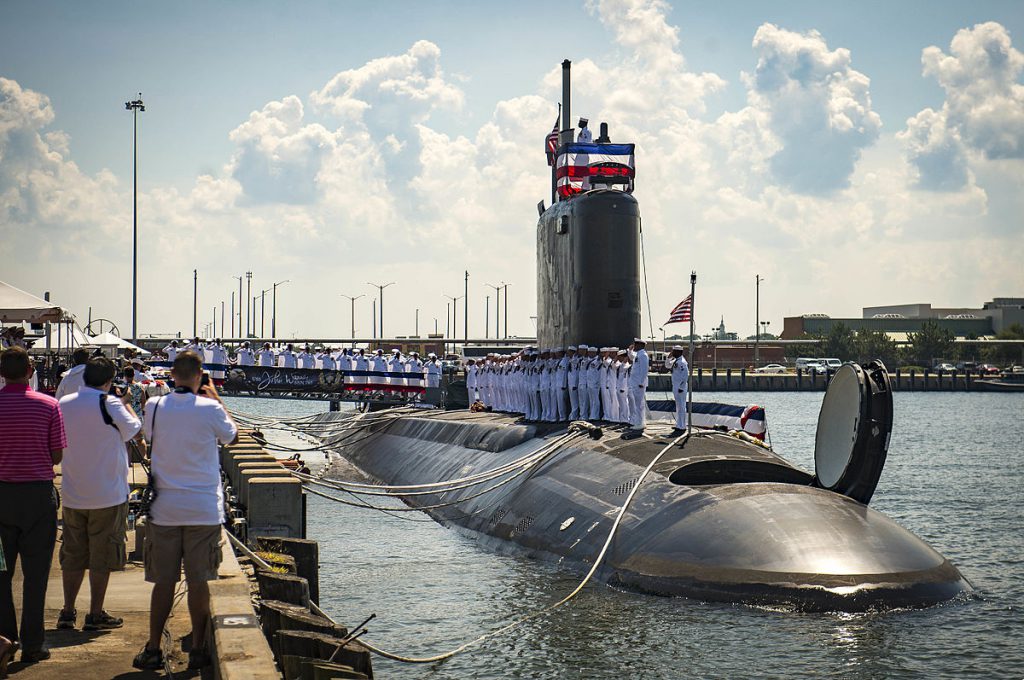
| General Characteristics: Virginia Class | |
| Builder: | General Dynamics Electric Boat and Huntington Ingalls Industries – Newport News Shipbuilding. |
| Propulsion: | One nuclear reactor, one shaft |
| Length: | 377 feet |
| Beam: | 33 feet |
| Displacement: | Approximately 7,800 tons submerged |
| Speed: | 25+ knots (28+ miles per hour) |
| Crew: | 132: 15 officers; 117 enlisted. |
| Armament: | Tomahawk missiles and MK48 torpedoes, four torpedo tubes on all SSNs.
|
The Virginia Class is the latest class of advanced capability nuclear powered fast attack submarines (SSN). It helps ensure our future national security by providing theater commanders with an affordable and flexible multi-mission stealth platform that replaces the aging fleet of Los Angeles Class attack submarines. Specifically designed for the post-Cold War threat environment, the Virginia Class is tailored to excel in a wide range of warfighting missions.
The Virginia Class has several innovations that significantly enhance its warfighting capabilities with an emphasis on littoral operations. Virginia Class SSNs have a fly-by-wire ship control system that provides improved shallow-water ship handling. The class has special features to support special operation forces. The torpedo room can be reconfigured to house a large number of special operation forces and all their equipment for prolonged deployments and future off-board payloads. The class also has large lock-in / lock-out chamber for divers. In Virginia Class SSNs, traditional periscopes have been supplanted by two Photonics Masts that house color, high-resolution black and white, and infrared digital cameras atop telescoping arms. With the removal of the barrel periscopes, the ship’s control room has been moved down one deck and away from the hull’s curvature, affording it more room and an improved layout that provides the commanding officer with enhanced situational awareness. Additionally, through the extensive use of modular construction, open architecture, and commercial off-the-shelf components, the Virginia Class is designed to remain state of the practice for its entire operational life through the rapid introduction of new systems and payloads.
Together, the shipbuilders, industry suppliers and the Navy consistently deliver Virginia Class submarines under budget and ahead of schedule.
Virginia Class Design Evolution

The Virginia Class submarine design has continued to evolve since USS Virginia (SSN 774) was first commissioned in 2004. Each successive Virginia Class SSN Block incorporates additional capabilities and advanced technology while reducing costs. Like the last of the preceding Los Angeles-class attack submarines, the first two blocks of Virginia Class have a vertical launch system (VLS) in the bow for 12 Tomahawk missiles. Starting with Virginia Class Block III, two key design changes were made:
- The VLS in the bow was replaced by two large diameter payload tubes utilizing the same “multiple all-up-round canister” (MAC) concept as the Ohio Class guided missile submarine (SSGN). Each payload tube can carry six (6) Tomahawk missiles.
- The traditional sonar sphere was replaced by the Large Aperture Bow array

About 40% of the original Virginia Class bow was redesigned for Virginia Class Block III. This design investment reduced the overall procurement costs and permitted the construction of two Virginia-class attack submarines per year beginning in 2011.

The Virginia Payload Module (VPM) represents the next major design change to the Virginia Class starting with Block V. The VPM is a new 84 foot section inserted into the existing submarine design that contains an additional four (4) large diameter payload tubes, similar to the bow payload tubes added in Block III. Unlike the bow payload tubes, the VPM payload tubes can each carry seven (7) Tomahawk missiles. Future VPM equipped submarines are the most cost effective way to restore the Navy’s undersea strike capacity, which will drop by 60% as the Ohio Class SSGN force will be retired by 2028. The first VPM equipped submarine will begin construction in 2019.
VPM’s open architecture design enables the submarine to deliver a large variety of capabilities including weapons, unmanned systems including Large Displacement Unmanned Undersea Vehicles, seabed sensors and other undersea capabilities.
As the threats to national security around the world continue to change and evolve, the submarine industrial base will continue to deliver a submarine that allows the Navy to meet these challenges.
